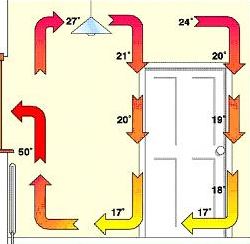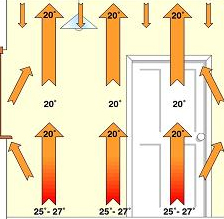Electric Underfloor Heating System - Space saving,safe and energy efficient heating
Bespoke Home & Flooring bring you the future in SPACE SAVING, SAFE AND ENERGY EFFICIENT Heating
 Guaranteed to be 20% cheaper than any other like for like system. In addition to that a third of the cost of a comparable water system.
Guaranteed to be 20% cheaper than any other like for like system. In addition to that a third of the cost of a comparable water system.
It’s now generally accepted that underfloor heating (UFH) offers distinct advantages over warm air systems and radiators. It is the most comfortable form of heating because of its high radiant content, it’s completely unobtrusive, is safer and more hygienic, and can in most cases be cheaper to run and more cost effective, it can also be linked to the new generation of solar tube energy systems that run off the suns release of ultraviolet light that work on none sunny days (it just needs to be daylight, but it also work during late dark night times.
However, in the midst of a drive for a low carbon economy, with interest in renewable energy increasing day by day, it’s worth reconsidering why UFH is also more energy-efficient. We first must consider current / conventional radiator heaters
Conventional convection heating – typical /conventional radiator systems
Any form of heating that uses gas to warm water then transfer the radiator (heat exchanger) that warms the air to transfer heat energy to the structures, furnishings and – eventually - the occupants, starts at a disadvantage.
 Radiators are generally sited either below, or close to windows and are hot by comparison with room air temperature. Standard practice is to size radiators with 70OC mean water temperature and 20OC room air temperature. This requires a Flow/Return of 75/65OC and boiler output higher than 75OC.
Radiators are generally sited either below, or close to windows and are hot by comparison with room air temperature. Standard practice is to size radiators with 70OC mean water temperature and 20OC room air temperature. This requires a Flow/Return of 75/65OC and boiler output higher than 75OC.
Air in contact with the radiator heats up; becomes buoyant and rises to the ceiling. It’s then pushed across the ceiling by warm air coming behind. As it crosses the ceiling, the air begins to cool and to drop back into the room - giving up energy to the structure of the room and its furnishings. It is coolest at floor level where it returns to the radiator for the convection cycle to be repeated.
The radiator must heat the air sufficiently to get it up to the ceiling and then across to the rear of the room; otherwise there’s only local convection near the radiator.
In any convective heating system the warmest air is up at the ceiling, while the coldest is down at floor level.
Radiant heat - Under floor heating process
Removal of the radiators and run Under floor pipes round the sub floors in various loop systems to control and structure the heating, within the property needs less heat input i.e. less Gas energy when using conventional gas boilers, that heat the water to a much lower temperature and hence us less gas in heating to and keeping it at this temperature. One of the principal reasons for use of this system is because it need less energy input for the same heat room temperatures.
 A heated floor begins to radiate as soon as it becomes warmer than the room air temperature. This can occur with air temperature of 10OC and floor temperature of 12OC. Typically, in a new build, a floor surface temperature of 25-27OC is needed to maintain a room air temperature of 20OC.
A heated floor begins to radiate as soon as it becomes warmer than the room air temperature. This can occur with air temperature of 10OC and floor temperature of 12OC. Typically, in a new build, a floor surface temperature of 25-27OC is needed to maintain a room air temperature of 20OC.
Radiant energy from the floor strikes all the other surfaces in the room, which absorb some of the energy, and reflect the rest. As these surfaces absorb energy, they warm up and begin to radiate, directing energy right down into the corners of the room, so there are no cold spots or cold floor draughts.
Almost all the radiant energy that strikes the window is reflected back into the room. Very little transfers through the glass.
UFH offers five principal energy benefits:
Cooler air in front of the window
With radiators, the hottest air in the whole room is in front of, or adjacent to, the window, which is the weakest thermal element in the whole room. Windows are often U=2.2 compared with external wall U=0.3 so that, area for area, windows can lose energy seven times more quickly. At night time, drawn curtains that extend down over the radiator ensure that warm air from the radiator is simply transferred out the window!
The thermal gradient can be 50OC inside and -1OC outside whereas, with UFH, the thermal gradient is more like 20OC inside and -1OC outside.
Cooler air at ceiling level
With convective heating, the air temperature at ceiling level is higher than it is with UFH, and the thermal loss through the ceiling is consequently higher. As the ceiling height increases, so the savings from UFH increase.
Lower losses through walls and infiltration
With radiators, air is used to heat the structure of the room and its contents. With UFH, room air only warms as a consequence of coming into contact with warm surfaces – radiant energy from the floor surface does not warm the air directly. With radiators, the air heats the room. With UFH, the room heats the air. Global experience shows that UFH users voluntarily turn down the room thermostats 1-3OC by comparison with radiator systems. The consequence of using room air temperature, even 1OC lower, is reduced energy loss through walls and reduced energy needed to heat incoming ventilation air.
Lower losses from distribution pipes
The actual water temperature required to achieve the design floor surface temperature of 25-27OC depends on the conductivity of the floor structure and the floor finish, but is invariably lower with UFH than with radiators. Consequently, the losses from the pipes carrying heated water to each room are significantly lower, even after taking equivalent pipe insulation into account.
Better use of energy-efficient water heaters
UFH ensures a condensing boiler will condense all the time. To condense the flue gases, such a boiler needs return water temperature lower than 53OC. UFH can provide this - radiators working at 70OC mean boilers will generally only condense during warm up.
UFH complements a heat pump because it can provide effective heating with lower flow temperatures, raising its COP.
UFH also works well with low-grade, waste heat from a manufacturing process that might otherwise be discarded or heated water from a CHP generator.
And finally let’s put an end to three old wives’ tales.
Some contend that downward heat loss from UFH is higher than from radiator or warm air systems. Any difference has reduced significantly as Building Regulations have forced all buildings to have high levels of floor insulation.
Some maintain that high mass UFH systems, where pipe or heating cable is embedded in thick concrete or screed, are inefficient. Only if misuse makes them so! Such systems fitted with simple room thermostats set much too high or low, will obviously use a great deal of energy. However, if fitted with programmable room thermostats, particularly ones that modulate as the room air temperature approaches the set point, they can be very efficient. Even super-efficient city cars use a lot of petrol if they are continually thrashed.
Some believe that UFH takes much longer to warm up than a radiator system. In fact, while a high mass UFH may take longer to warm up from cold, a low mass UFH system can be even quicker to warm up than radiators. Proper zone control means that even large buildings can be regulated to ensure a warm welcome.